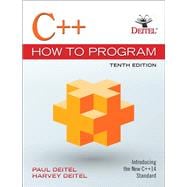The best-selling C++ How to Program is accessible to readers with little or no programming experience, yet comprehensive enough for the professional programmer. The Deitels’ signature live-code approach presents the concepts in the context of full working programs followed by sample executions. The early objects approach gets readers thinking about objects immediately–allowing them to more thoroughly master the concepts. Emphasis is placed on achieving program clarity and building well-engineered software. Interesting, entertaining, and challenging exercises encourage students to make a difference and use computers and the Internet to work on problems. To keep readers up-to-date with leading-edge computing technologies, the Tenth Edition conforms to the C++11 standard and the new C++14 standard.
Also available with MyLab Programming
This title is also available with MyLab
Note: You are purchasing a standalone product; MyLab Programming does not come packaged with this content. Students, if interested in purchasing this title with MyLab Programming, ask your instructor for the correct package ISBN and Course ID. Instructors, contact your Pearson representative for more information.
If you would like to purchase both the physical text and MyLab Programming, search for:
0134583000 / 9780134583006 C++ How to Program Plus MyLab Programming with Pearson eText -- Access Card Package, 10/e
Package consists of:
- 0134448987 / 9780134448985 MyLab Programming with Pearson eText -- Access Code Card -- for C++ How to Program (Early Objects Version)
- 0134448235 / 9780134448237 C++ How to Program








